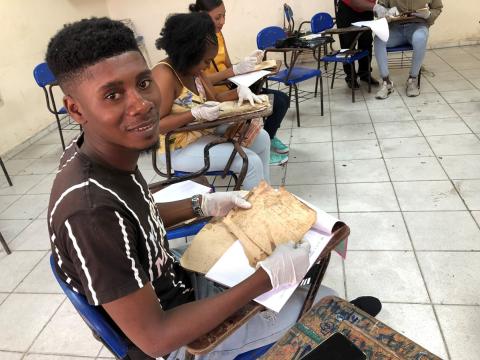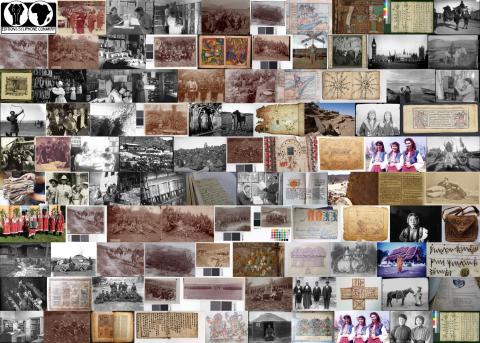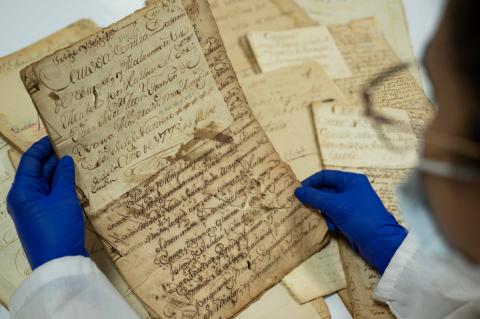Aims and objectives
This pilot project has two main components. The first will inventory the historical, notarial and judicial collections held in Caloto, Colombia in preparation for a major research project to relocate this material within Colombia and make it widely available via digital archives. The perilous condition of the materials calls for an immediate assessment to identify the most valuable and deteriorated materials for an initial sample digitisation. The second element of the project will locate and digitise privately owned manuscripts of grima, a dynamic martial art using the machete, lance, or unarmed body that was developed by enslaved Africans and their descendants.
First founded in 1543, Caloto Viejo (Old Caloto) was the administrative capital of a wide region northeast of Popayán that included Native American groups, European settlers, their enslaved Africans, and maroon communities formed by escaped slaves. By the 1940s this rural region had not yet experienced industrialisation, yet many of Caloto Viejo’s towns had become autonomous districts. Now only the head of a small municipality, Caloto still houses the pre-modern documents of Caloto Viejo.
This project will inventory the endangered collections held in Caloto’s alcaldía (town hall) and notary and digitise the most valuable and deteriorated documents. The alcaldía’s judicial and historical collections have not yet been surveyed, but go back at least to the mid nineteenth century. The judicial documents are in a storage room managed by legal clerks who have little appreciation for early hand written materials and regularly dispose of them to create space for modern documents. The 344 boxes of the historical collection are in a separate room. In 2006, 3,000 documents were inventoried and placed in acid-free boxes on shelves. The bulk of the collection though remains piled on the floor and in danger of mould. Exacerbating the impact of a hot and humid climate, the room’s door and windows is just a grating, exposing the documents to water damage during rains. The alcaldía staff store kitchen supplies and instruments on top of the documents, leaving them in serious danger of attracting vermin. Guerrilla soldiers controlling the territory across the Palo River, just a few blocks away, make frequent bombing attacks on Caloto. Since the alcaldía and adjacent police station are primary targets for guerrilla attacks, these documents are in grave danger of immediate destruction. The notarial collection is in a more secure location from guerilla attacks, but contains eighteenth century documents, including documents on the Páez Indians, that are in danger of deterioration due to a lack of climate or humidity control.
All the material from the historical collection and all of the pre-modern material from the judicial and notarial collection will be placed in acid-free boxes and placed on shelves to slow its deterioration. A record will be produced for each document inventoried and will be combined into a searchable digital catalogue for the collection. Documents assessed to be of highest priority will be digitised based on the historical value for researchers and on the level of physical deterioration.
The second part of the project will focus on digitising a rare and valuable body of cartillas de malicia held in private collections by masters of the numerous distinct styles of grima. Completely overlooked by scholars, these hand written and illustrated books have been passed from master to disciple for generations to ensure the undiluted transmission of each lineage’s history and pedagogy. Representing a unique documentary heritage as perhaps the only genre written/illustrated by poor blacks since the era of slavery, cartillas record techniques, experiences of past grima experts, religious beliefs, and cultural practices from the perspective of the poor, whose unique history scholars are otherwise left to try and glean from the writings of elites.
Caloto Viejo’s grima experts formed the famous macheteros de la muerte, feared shock troops in the numerous nineteenth-century military conflicts. Afro-Colombians exercised their military expertise to ensure the end of slavery and to make political claims on citizenship in the 1850s and 60s. In elite sources these black soldiers are mere pawns, but cartillas illustrate such conflicts from a popular perspective. Later grima experts led black resistance struggles against the plantations that destroyed black pastoralism, land tenancy, and communal land systems in the 1890s and 1910s. Yet during a conflict with Peru in the 1930s, the government reformed a battalion of macheteros from Puerto Tejada, who heroically overcome the more modern firearms of Peru, but are totally absent from elite narratives of the conflict. In the wake of their success, many whites and mestizos began joining grima academies in the 1930s and 40s, while grima remained an important Afro-Colombian resource for conflict resolution, economic income, and political participation. Political oppression during the civil unrest called La Violencia ultimately ended most academies around the late 1940s.
These manuscripts are in utmost peril. Living academy graduates are predominantly in their eighties and nineties, and since cartillas are burned after the death of their owners if they do not have disciples, this entire genre of documents will vanish without a trace. In past research trips to Colombia, more than twenty living masters have been encountered and all but two have agreed to participate in this project through viewing and digitising their manuscripts, dating from the 1850s to the 1940s. This project aims to locate more private collections in the hope of saving this rare archival genre, dating back to at least the 1830s.
Caloto Viejo’s documents are crucial for Afro-Colombian history. Caloto and adjacent regions of the Cauca constituted the nineteenth century heartland slavery, with Julio Arboleda’s massive Japio estate in Caloto the towering symbol of landholding power. However, in 1850 local Afro-Colombians turned machetes and whips against slave-owners, and in 1851 defeated the Conservative army headquartered at Arboleda’s estate during the ensuing civil war, thus ensuring the abolition of slavery through force of arms. The unique genre of cartillas written by poor blacks who played crucial but unrecognised roles in the abolition and military struggles of Colombia will greatly enrich national histories. The archives of Caloto are important for tracing the wider history of elites, Indians, and blacks, and essential for salvaging the local history of important Afro-Colombian towns such as Puerto Tejada or the scholarly unknown maroon community of Caricacé with unique linguistic traditions, whose documentary history exists only in the endangered collections of Caloto.
All of the digital images will be deposited in the Centro Virtual Jorge Isaac digital collection of the University of Valle, the nearest major university, to be made freely accessible for researchers in Colombia. A second set of the images will be sent to the British Library. The project will result in a staff of twenty-five trained archivists to carry out the digitisation of all the archival material during a future major grant. The project will also locate a suitable archival home in Colombia where the material can be both properly preserved and made available to researchers.
Outcomes
This project completed the inventory of the original pre-modern materials found in the archival collection of Caloto. The staff cleaned (brushed and removed staples), inventoried, and filed each document into folders, and placed them in acid free storage boxes. This material mostly fell into the range from 1850 to 1950. A sample digitization was made of some of these materials.
The records copied by this project have been catalogued as:
- EAP650/1 Archivo Historico de Caloto [16th to 20th Century]
- EAP650/2 Luis Vidal Collection [1940s]
- EAP650/3 Luis Angulo Collection [1930s - 1940s]
Due to the cyber-attack on the British Library in October 2023, the archives and manuscripts database is currently inaccessible and we are unable to provide links to the catalogue records for this project.




